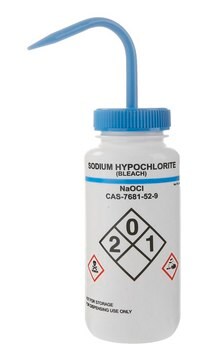All Photos(1)
About This Item
Linear Formula:
NaClO
CAS Number:
Molecular Weight:
74.44
MDL number:
UNSPSC Code:
12352300
PubChem Substance ID:
grade:
LR
form:
liquid
Recommended Products
grade
LR
product line
Vetec™
form
liquid
concentration
4%
SMILES string
[Na+].[O-]Cl
InChI
1S/ClO.Na/c1-2;/q-1;+1
InChI key
SUKJFIGYRHOWBL-UHFFFAOYSA-N
Looking for similar products? Visit Product Comparison Guide
General description
Sodium hypochlorite (NaOCl), which is generally referred to as bleach, is a strong oxidizing agent. It has been used in many organic reactions like epoxidation of olefins, and oxidation of some hydrocarbons, aldehydes, alcohols, aliphatic ethers, etc.
Application
Sodium hypochlorite can be used in the synthesis of methyl phenyl glyoxylate by oxidation of methyl mandelate.
Legal Information
Vetec is a trademark of Merck KGaA, Darmstadt, Germany
Signal Word
Danger
Hazard Statements
Precautionary Statements
Hazard Classifications
Aquatic Acute 1 - Aquatic Chronic 2 - Eye Dam. 1 - Skin Irrit. 2
Storage Class Code
12 - Non Combustible Liquids
WGK
WGK 2
Flash Point(F)
Not applicable
Flash Point(C)
Not applicable
Choose from one of the most recent versions:
Already Own This Product?
Find documentation for the products that you have recently purchased in the Document Library.
Run Zhang et al.
Small (Weinheim an der Bergstrasse, Germany), 15(2), e1803712-e1803712 (2018-12-15)
Responsive nanoprobes play an important role in bioassay and bioimaging, early diagnosis of diseases and treatment monitoring. Herein, a upconversional nanoparticle (UCNP)-based nanoprobe, Ru@UCNPs, for specific sensing and imaging of hypochlorous acid (HOCl) is reported. This Ru@UCNP nanoprobe consists of
Sodium Hypochlorite (NaOCl)
Veisi H
Synlett, 2007(16), 2607-2608 (2007)
Sodium hypochlorite
e-EROS Encyclopedia of Reagents for Organic Synthesis. (2013)
Selective oxidation of methyl mandelate to methyl phenyl glyoxylate using liquid-liquid-liquid phase transfer catalysis
Yadav GD and Motirale BG
Chemical Engineering Journal, 156(2), 328-336 (2010)
Zhi Liu et al.
Journal of hazardous materials, 353, 505-513 (2018-05-02)
This study investigated the formation of toxic iodinated trihalomethanes (I-THMs) during breakpoint chlorination of iodide-containing water. Impact factors including I- concentration, natural organic matter (NOM) concentration and type, pH as well as Br-/I- molar ratio were systematically investigated. Moreover, the
Our team of scientists has experience in all areas of research including Life Science, Material Science, Chemical Synthesis, Chromatography, Analytical and many others.
Contact Technical Service







